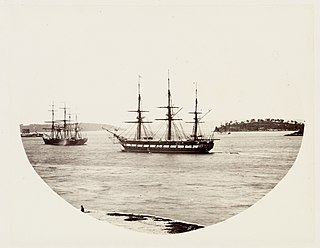
HMS Clio was a wooden 22-gun Pearl-class corvette, built at Sheerness Dockyard and launched on 28 August 1858. She was the flagship of the Australia Station between 3 September 1870 and 16 October 1873, and from 1876 was used as a school ship.
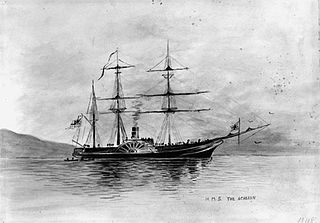
HMS Acheron was the last Hermes-class wooden paddle sloop ordered for the Royal Navy. She was launched at Sheerness in 1838. She spent two commissions in the Mediterranean before being reclassed as a survey ship in 1847. Between 1848 and 1851 she made a coastal survey of New Zealand, the first such survey since Captain Cook. She was paid off at Sydney and was tender to HMS Calliope. She was sold at Sydney in 1855.

HMS Niger was originally slated to be built as a Sampson designed sloop; however, she was ordered as a First-Class sloop with screw propulsion on 20 February 1845 to be built at Woolwich Dockyard, along the design developed by Oliver Lang and with a hull like the Basilisk designed paddle sloops. Her armament and engine were to be like the Encounter Design building at Pembroke. A second vessel (Florentia) was ordered on 26 March 1846 but after her keel was laid at Pembroke Dockyard, her construction was suspended on 6 October 1846 then cancelled three years later, on 22 May 1849. Niger She conducted important propulsion trials, finally proving the superiority of screw propulsion and served in West Africa, the Crimea, China, the East Indies and Australia. She took part in the New Zealand wars in 1860 and was sold for breaking in 1869.
HMS Elk was a 482-ton displacement, 16-gun Acorn-class brig-sloop of the Royal Navy launched on 29 September 1847 from the Chatham Dockyard.

HMS Harrier was a Royal Navy Cruizer-class screw sloop launched in 1854. She took part in the Crimean War, served on the Australia Station and took part in the New Zealand Wars. She was broken up in 1865
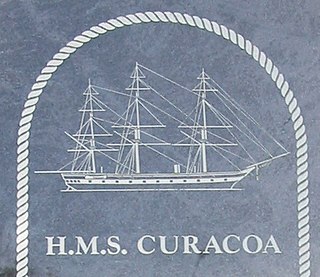
HMS Curacoa was a 31-gun Tribune-class screw frigate launched on 13 April 1854 from Pembroke Dockyard.
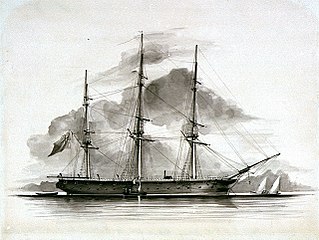
HMS Brisk was a 14-gun wooden-hulled screw sloop designed by the Committee of Reference as part of the 1847 program. She is considered an enlarged Rattler with the design approved in 1847. She was ordered on 25 April 1847 from Woolwich Dockyard as a 10-gun sloop, but the guns were later increased due to the Russian War, to 14 guns by increasing the number of 32-pounder guns. She was launched on 2 June 1851 from Woolwich Dockyard. She served in the Russian War of 1854- 55 and as part of the Southern African anti-slavery patrol, with a final commission on the Australian Station. She was sold in 1870 for use in an pioneer, but unsuccessful, telegraph service.

HMS Salamander was one of the initial steam powered vessels built for the Royal Navy. On 10 January 1831 the First Sea Lord gave orders that four paddle vessels be built to competitive designs. The vessels were to be powered by Maudslay, Son & Field steam engines, carry a schooner rig and mount one or two 10-inch shell guns. Initially classed simply as a steam vessel (SV), she was re-classed as a second-class steam sloop when that categorization was introduced on 31 May 1844. Designed by Joseph Seaton, the Master Shipwright of Sheerness, she was initially slated to be built in Portsmouth, and was changed to Sheerness Dockyard. She was launched and completed in 1832, took part in the Second Anglo-Burmese War and was broken up in 1883.

HMS Falcon was a 17-gun Royal Navy Cruizer-class sloop launched in 1854. She served in the Baltic Sea during the Crimean War and then in North America, West Africa and Australia. She was sold for breaking in 1869.

HMS Hecate was a 4-gun Hydra-class paddle sloop launched on 30 March 1839 from the Chatham Dockyard.
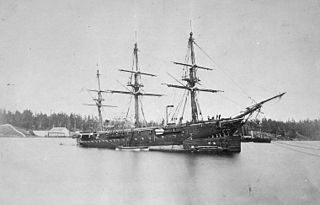
HMS Charybdis was a 21-gun Royal Navy Pearl-class corvette launched on 1 July 1859 at Chatham Dockyard.

HMS Blanche was a 1760-ton, 6-gun Eclipse-class wooden screw sloop built for the Royal Navy in the mid-1860s by Chatham Dockyard.

HMS Cossack was a Cossack-class corvette which was laid down as Witjas for the Imperial Russian Navy. She was seized due to the Crimean War breaking out whilst she was under construction and taken into service with the Royal Navy.

HMS Torch was an Alert-class sloop of the Royal Navy, built at Sheerness Dockyard and launched in 1894. She served in Australia and New Zealand and was transferred to New Zealand as a training ship in 1917, being renamed HMS Firebrand at the same time. She was sold in 1920 and converted to a refrigerated ship with the new name Rama. She ran aground in the Chatham Islands in 1924 and was abandoned.
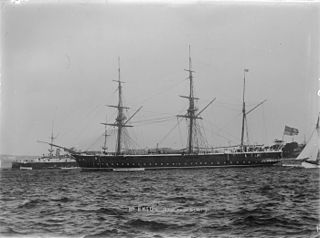
HMS Opal was an Emerald-class corvette of the Royal Navy, laid down as Magicienne by William Doxford & Sons Ltd, Sunderland and launched on 9 March 1875.

HMS Basilisk was a first-class paddle sloop of the Royal Navy, built at the Woolwich Dockyard and launched on 22 August 1848.

HMS Diamond was an Amethyst-class corvette in service 1874–89.

HMS Barracouta was the last paddle sloop built for the Royal Navy. She was built at Pembroke Dockyard and launched in 1851. She served in the Pacific theatre of the Crimean War, in the Second Opium War and in the Anglo-Ashanti wars. She paid off for the last time in 1877 and was broken up in 1881.
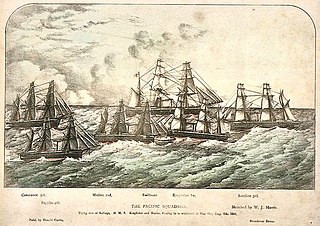
HMS Sappho was a Fantome-class sloop, of the Royal Navy, built by Wigram & Sons, Blackwall and launched on 20 November 1873.

HMS Dido was an 18-gun Daphne-class corvette built for the Royal Navy during the 1830s.




















